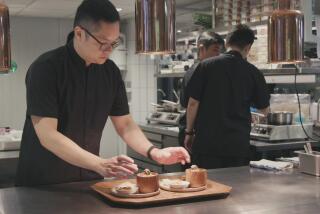NONFICTION - Dec. 19, 1993
- Share via
THE RAJ AT TABLE: A Culinary History of the British in India by David Burton (Faber & Faber: $22.95; 239 pp.) “This is a handful of Cardamom,/ This is a lump of ghee/ This is millet and chillies and rice/ And Supper for thee and me.” Thus spake Kipling in 1901, at the height of the British Raj (rule) in India. They’d been there lang syne, lured by the whiff of spices fully 20 years before the first Pilgrim broke corn bread with those other Indians. Moreover, David Burton has managed to spin a social history of the era by way of the Colonial gut, an alimentary-school primer as lively as it is tempting.
Early merchants went native, not only eating indigenous dhals, renewable stews and “Bombay duck” (crispy dried fish) but also wearing baggy trousers, smoking the hubbly-bubbly, chewing betel nuts and breakfasting on burnt wine and peacock. As the Brits began to assume an “attitude of racial superiority,” a scorn for Indian dishes was affected in favor of “French” cuisine that wasn’t: for podolongcai au jus, read gourd and gravy. Best to keep cook on your side, though, or he’d boil the foie gras or sew sheep’s hoofs to goat limbs and serve “leg of mutton.”
British and Indians tastes finally converged, and provocative recipes run rampant across this book. With persistence and pluck you will be able to serve ding-dong, hurry-scurry and kul-kuls; red-herring burta, dried bomboes, Jewish curry and soused fish. While cooking, you may want to reflect on the early coffee-house custom of barring women--except for concert nights: “On such occasions, hookahs were banned.” I should hope so.
More to Read
Sign up for our Book Club newsletter
Get the latest news, events and more from the Los Angeles Times Book Club, and help us get L.A. reading and talking.
You may occasionally receive promotional content from the Los Angeles Times.










